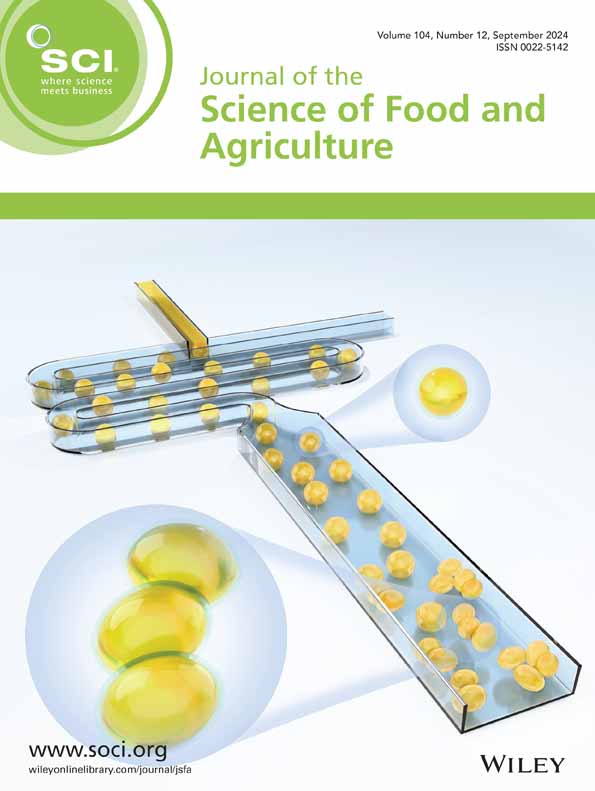求助PDF
{"title":"Recent developments in the valorization of agri-food waste and byproducts by fermentation.","authors":"Fatih Tornuk, Perihan Kubra Akman","doi":"10.1002/jsfa.70160","DOIUrl":null,"url":null,"abstract":"<p><p>The agri-food industry generates huge amounts of waste and byproducts (AFWBs), which threaten the environment if not properly managed. Biological approaches such as fermentation have been proven to be versatile routes for increasing the nutritional potential of AFWBs and production of value-added bioactive compounds. The present paper reviews the results of recent studies that have been conducted on the effect of fermentation of AFWBs from different origins and fermentation techniques on generation of bioactive compounds. The study focuses specifically on studies conducted from 2020 to present. Types of microorganisms used in fermentations, fermentation routes as well as challenges towards upscaling and commercialization strategies for fermentation of AFWBs are also reviewed in this paper. Studies have indicated the production of diverse bioactive compounds including bioactive peptides, phenolics, single-cell proteins, polyunsaturated fatty acids by fermentation of AFWBs with selected bacteria, filamentous fungi and yeasts. Filamentous fungi, especially Aspergillus niger strains, have been used as starter cultures for improving the polyphenolic potential of AFWBs by fermentation, while mainly yeasts have been utilized for single-cell protein production. Peptides such as bioactive peptides and amino acids have been produced by bacterial cultures such as lactic acid bacteria and Bacillus sp. using a variety of plant- or animal-based AFWBs. Lactic acid, citric acid, essential fatty acids and flavoring compounds were also among the compounds aimed for production from AFWBs. Although the scale-up and commercialization of fermentation processes have been studied for a long time, there are still many obstacles and challenges. © 2025 Society of Chemical Industry.</p>","PeriodicalId":17725,"journal":{"name":"Journal of the Science of Food and Agriculture","volume":" ","pages":""},"PeriodicalIF":3.5000,"publicationDate":"2025-09-02","publicationTypes":"Journal Article","fieldsOfStudy":null,"isOpenAccess":false,"openAccessPdf":"","citationCount":"0","resultStr":null,"platform":"Semanticscholar","paperid":null,"PeriodicalName":"Journal of the Science of Food and Agriculture","FirstCategoryId":"97","ListUrlMain":"https://doi.org/10.1002/jsfa.70160","RegionNum":2,"RegionCategory":"农林科学","ArticlePicture":[],"TitleCN":null,"AbstractTextCN":null,"PMCID":null,"EPubDate":"","PubModel":"","JCR":"Q1","JCRName":"AGRICULTURE, MULTIDISCIPLINARY","Score":null,"Total":0}
引用次数: 0
引用
批量引用
Abstract
The agri-food industry generates huge amounts of waste and byproducts (AFWBs), which threaten the environment if not properly managed. Biological approaches such as fermentation have been proven to be versatile routes for increasing the nutritional potential of AFWBs and production of value-added bioactive compounds. The present paper reviews the results of recent studies that have been conducted on the effect of fermentation of AFWBs from different origins and fermentation techniques on generation of bioactive compounds. The study focuses specifically on studies conducted from 2020 to present. Types of microorganisms used in fermentations, fermentation routes as well as challenges towards upscaling and commercialization strategies for fermentation of AFWBs are also reviewed in this paper. Studies have indicated the production of diverse bioactive compounds including bioactive peptides, phenolics, single-cell proteins, polyunsaturated fatty acids by fermentation of AFWBs with selected bacteria, filamentous fungi and yeasts. Filamentous fungi, especially Aspergillus niger strains, have been used as starter cultures for improving the polyphenolic potential of AFWBs by fermentation, while mainly yeasts have been utilized for single-cell protein production. Peptides such as bioactive peptides and amino acids have been produced by bacterial cultures such as lactic acid bacteria and Bacillus sp. using a variety of plant- or animal-based AFWBs. Lactic acid, citric acid, essential fatty acids and flavoring compounds were also among the compounds aimed for production from AFWBs. Although the scale-up and commercialization of fermentation processes have been studied for a long time, there are still many obstacles and challenges. © 2025 Society of Chemical Industry.
农业食品废弃物和发酵副产物价值的最新进展。
农业食品工业产生了大量的废物和副产品(AFWBs),如果管理不当,会对环境造成威胁。发酵等生物方法已被证明是增加AFWBs营养潜力和生产增值生物活性化合物的通用途径。本文综述了不同来源的AFWBs发酵及发酵工艺对生物活性物质产生影响的最新研究成果。该研究特别关注从2020年到现在进行的研究。本文还综述了用于发酵的微生物类型、发酵途径以及AFWBs发酵升级和商业化策略面临的挑战。研究表明,通过与选定的细菌、丝状真菌和酵母发酵AFWBs,可以产生多种生物活性化合物,包括生物活性肽、酚类物质、单细胞蛋白质、多不饱和脂肪酸。丝状真菌,特别是黑曲霉菌株,已被用作发酵剂,通过发酵提高AFWBs的多酚潜能,而主要是酵母被用于单细胞蛋白质的生产。利用多种植物或动物AFWBs,乳酸菌和芽孢杆菌等细菌培养物已生产出生物活性肽和氨基酸等多肽。乳酸、柠檬酸、必需脂肪酸和调味化合物也在AFWBs的目标化合物中。虽然发酵工艺的规模化和商业化已经进行了很长时间的研究,但仍然存在许多障碍和挑战。©2025化学工业协会。
本文章由计算机程序翻译,如有差异,请以英文原文为准。

 求助内容:
求助内容: 应助结果提醒方式:
应助结果提醒方式:


